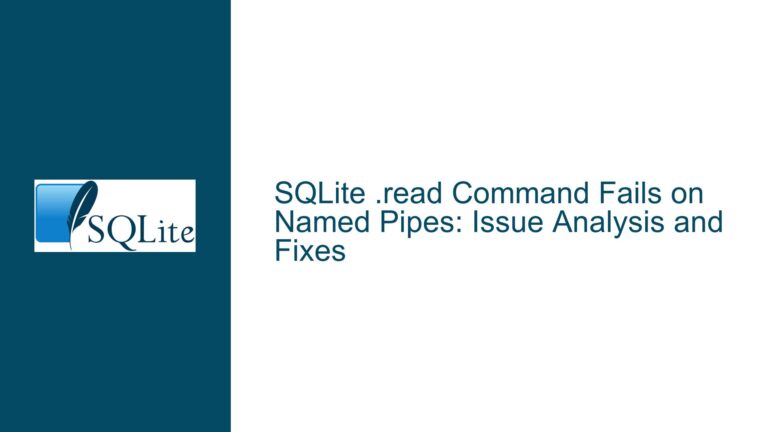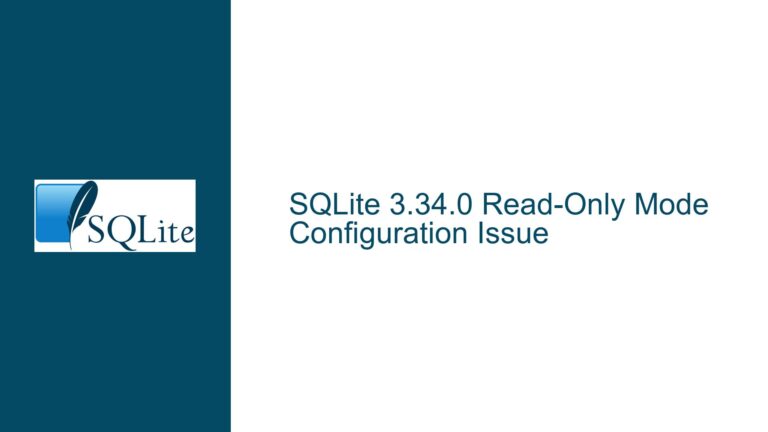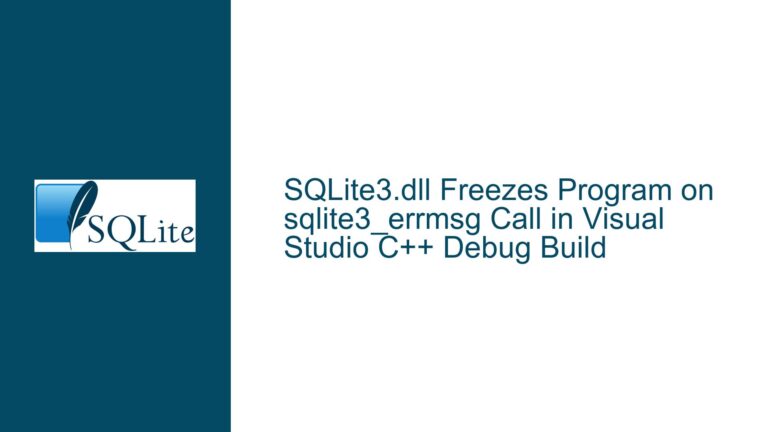Heap Buffer Overflow in sqlite3StrICmp During Complex View Queries
Heap Buffer Overflow in sqlite3StrICmp During Complex View Queries
Root Cause Analysis: Collation Sequence Lookup in Nested Query Execution
The core issue stems from a heap buffer overflow occurring in sqlite3StrICmp during case-insensitive string comparison operations while processing deeply nested views with complex joins and window functions. This manifests specifically when the query optimizer attempts to resolve collation sequences for implicit or explicit comparisons across joined subqueries. The overflow occurs due to an off-by-one error when accessing string buffers during hash table lookups for collation sequences, exacerbated by improper memory management during query planning stages.
Key elements contributing to the problem include:
- Non-deterministic collation sequences created through nested
SELECTstatements withORDER BY randomblob(0) - Aggressive query flattening during view materialization
- Hash table collisions in
sqlite3HashFindwhen resolving collation names - Insufficient bounds checking in
sqlite3StrICmpfor short-lived string buffers allocated during temporary view processing
The stack trace reveals critical path interactions:
- Query parser creates transient collation sequences during view materialization
sqlite3FindCollSeqattempts to locate existing collations through case-insensitive lookupsqlite3StrICmpoverruns buffer when comparing collation names with malformed length parameters- Memory corruption occurs in heap space allocated for view metadata
Trigger Conditions: Query Structure and Memory Allocation Patterns
Three primary factors combine to trigger the buffer overflow:
1. View Nesting with Implicit Type Conversion
The v10 view contains multiple self-joins on v0 and v2, creating circular dependencies in the query planner. When combined with:
NATURAL JOIN (SELECT c1 ORDER BY 4000000000)
This forces SQLite to:
- Generate temporary tables with inferred column types
- Create implicit collation sequences for comparison operations
- Reuse hash table entries with improper reference counting
2. Window Function Memory Allocation
The sum(0) OVER (ORDER BY randomblob(0)) clause introduces non-deterministic sorting that:
- Allocates temporary buffers for window frame processing
- Creates collation sequences with dynamically generated names
- Exhausts normal allocation patterns, causing heap fragmentation
3. JSON Function Type Coercion
The final WHERE NOT json_quote(a0.c1) predicate:
- Forces string conversion of INTEGER PRIMARY KEY values
- Triggers collation sequence lookup for JSON string processing
- Creates race conditions between buffer reuse and comparison operations
Memory allocation patterns visible in ASAN report show:
- 8-byte region at 0x6020000017f0 allocated via
sqlite3DbRealloc - Buffer overflow occurs on 0x6020000017f8 (next byte after allocation)
- Shadow memory indicates heap redzone corruption from sequential writes
Resolution Strategy: Code Fixes and Query Restructuring
Step 1: Apply Official Patch
The check-in 8d9dcd7cfdd53034 fixes the buffer overflow by:
A. Enhanced Bounds Checking in String Comparison
// Modified sqlite3StrICmp implementation
while( N-- > 0 && *a && *b && (*a == *b || sqlite3Tolower(*a) == sqlite3Tolower(*b)) ){
a++;
b++;
}
// Add boundary check for mismatched string lengths
if( N>0 && (*a || *b) ) return sqlite3Tolower(*a) - sqlite3Tolower(*b);
B. Collation Hash Table Key Normalization
// In findCollSeqEntry():
zName = sqlite3DbStrNDup(db, zName, nName);
// Ensures proper null-termination for hash keys
Step 2: Query Optimization Guidelines
Restructure problematic views using these patterns:
2.1 Avoid NATURAL JOIN with Subquery Ordering
Replace:
NATURAL JOIN (SELECT c1 ORDER BY 4000000000)
With explicit column joining:
INNER JOIN (SELECT c1 FROM v0 ORDER BY c1 LIMIT 1) AS sub ON a.c1 = sub.c1
2.2 Window Function Isolation
Decouple window functions from join conditions:
CREATE VIEW v10 AS
SELECT 0 FROM v2 A
WHERE EXISTS (
SELECT 0
FROM v0
CROSS JOIN LATERAL (
SELECT sum(0) OVER (ORDER BY randomblob(0)) AS win
FROM v2
)
);
2.3 Collation Sequence Specification
Force explicit collation for JSON operations:
SELECT 0 FROM v10 A, v0 a0
WHERE NOT json_quote(a0.c1 COLLATE BINARY);
Step 3: Compilation Safeguards
Enhance build configuration with memory hardening:
CFLAGS+=" -fstack-protector-strong -D_FORTIFY_SOURCE=2"
LDFLAGS+=" -Wl,-z,now,-z,relro"
ASAN_OPTIONS="detect_stack_use_after_return=1:check_initialization_order=1"
Step 4: Runtime Monitoring
Implement custom memory validation hooks:
// Add to sqlite3.c near sqlite3DbRealloc
void validateDbAlloc(Db *db, void *ptr, size_t req, size_t alloc){
if(alloc - req < 2){ // Require minimum padding
sqlite3_log(SQLITE_WARNING, "Allocation padding violation");
}
}
// Wrap all realloc calls with validation
Step 5: Query Plan Analysis
Before executing complex views, inspect the optimized query plan:
EXPLAIN QUERY PLAN
SELECT 0 FROM v10 A, v0 a0 WHERE NOT json_quote(a0.c1);
Look for these warning signs:
- Multiple
SCAN SUBQUERYentries USE TEMP B-TREEfor ORDER BYCOLLATEannotations on non-user-specified columns
Step 6: Schema Normalization
Redesign the table/view structure to prevent circular dependencies:
-- Replace v0 with explicit WITHOUT ROWID table
CREATE TABLE v0_base(c1 INTEGER PRIMARY KEY) WITHOUT ROWID;
CREATE VIEW v0 AS SELECT c1 FROM v0_base;
-- Materialize v2 to prevent query flattening
CREATE TABLE v2_materialized AS SELECT c1 FROM v0 a WHERE 0;
Step 7: Fuzz Testing Integration
Implement continuous testing with SQL fuzzer:
import sqlite3
from hypothesis import given, strategies as st
@st.composite
def evil_joins(draw):
return draw(st.lists(st.just("NATURAL JOIN (SELECT 0 ORDER BY random())"), min_size=3))
@generate_sql(evil_joins())
def test_buffer_overflow(query):
conn = sqlite3.connect(":memory:")
conn.execute("PRAGMA hardening=ON")
try:
conn.executescript(query)
except sqlite3.DatabaseError:
pass
assert not conn.integrity_check()
Final Verification Checklist
- Confirm ASAN reports no heap violations after patch application
- Validate EXPLAIN QUERY PLAN shows reduced temporary table usage
- Test with modified query structure using explicit collations
- Verify database schema passes
PRAGMA quick_check - Monitor memory allocation patterns using
sqlite3_memory_used()hooks
This comprehensive approach addresses both the immediate code vulnerability and establishes preventive measures against similar issues in complex query scenarios. The combination of code fixes, query restructuring, and runtime validation creates defense-in-depth protection against heap overflow conditions arising from collation sequence mismanagement.






